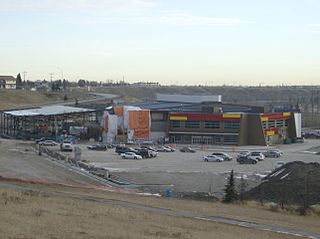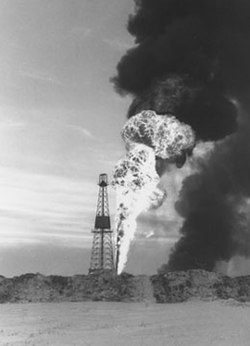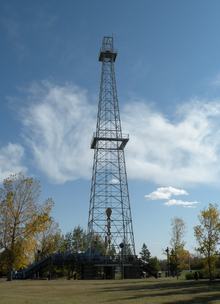
Imperial Oil Limited is a Canadian petroleum company. It is Canada's second-biggest integrated oil company. It is majority-owned by American oil company ExxonMobil with around 69.6 percent ownership stake in the company. It is a significant producer of crude oil, diluted bitumen and natural gas, Canada's major petroleum refiner, a key petrochemical producer and a national marketer with coast-to-coast supply and retail networks. It supplies Esso-brand service stations.

Petroleum production in Canada is a major industry which is important to the economy of North America. Canada has the third largest oil reserves in the world and is the world's fourth largest oil producer and fourth largest oil exporter. In 2019 it produced an average of 750,000 cubic metres per day (4.7 Mbbl/d) of crude oil and equivalent. Of that amount, 64% was upgraded from unconventional oil sands, and the remainder light crude oil, heavy crude oil and natural-gas condensate. Most of the Canadian petroleum production is exported, approximately 600,000 cubic metres per day (3.8 Mbbl/d) in 2019, with 98% of the exports going to the United States. Canada is by far the largest single source of oil imports to the United States, providing 43% of US crude oil imports in 2015.

George Maxwell Bell was a Canadian newspaper publisher, race horse owner and philanthropist. He was best known as the co-founder of FP Publications, Canada's largest newspaper syndicate in the 1960s. He built his newspaper empire after inheriting the Calgary Albertan, and its $500,000 debt, from his father in 1936. He repaid the debt by 1945 and proceeded to purchase papers across the country, including the Ottawa Journal and The Globe and Mail. Much of Bell's fortune was built on Alberta's burgeoning oil and gas industry. He formed several companies in the late 1940s which came to be worth millions of dollars when sold.

Canada's oil sands and heavy oil resources are among the world's great petroleum deposits. They include the vast oil sands of northern Alberta, and the heavy oil reservoirs that surround the small city of Lloydminster, which sits on the border between Alberta and Saskatchewan. The extent of these resources is well known, but better technologies to produce oil from them are still being developed.

Canada's natural gas liquids industry dates back to the discovery of wet natural gas at Turner Valley, Alberta in 1914. The gas was less important than the natural gasoline - "skunk gas" it was called, because of its distinctive odour - that early producers extracted from it. That natural gas liquid (NGL) could be poured directly into an automobile's fuel tank.

The Canadian petroleum industry arose in parallel with that of the United States. Because of Canada's unique geography, geology, resources and patterns of settlement, however, it developed in different ways. The evolution of the petroleum sector has been a key factor in the history of Canada, and helps illustrate how the country became quite distinct from her neighbour to the south.
Charles Richard Stelck, O.C., Ph.D., F.R.S.C., P.Geol. was a Canadian petroleum geologist, paleontologist, stratigrapher, and university professor. He is known for his pioneering work on unraveling the stratigraphy of the Western Canada Sedimentary Basin, and his inspired use of biostratigraphy as an exploration tool for finding petroleum and natural gas fields.

Canada's early petroleum discoveries took place near population centres or along lines of penetration into the frontier.

Natural gas has been used almost as long as crude oil in Canada, but its commercial development was not as rapid. This is because of special properties of this energy commodity: it is a gas, and it frequently contains impurities. The technical challenges involved to first process and then pipe it to market are therefore considerable. Furthermore, the costs of pipeline building make the whole enterprise capital intensive, requiring both money and engineering expertise, and large enough markets to make the business profitable.

Francis Murray Patrick McMahon was a Canadian oilman best known as the founder of Pacific Petroleums and the Westcoast Transmission Company. Time magazine called him "The man who did the most to open up northwest Canada's wilderness—and convince oilmen of its treasures."
The Leduc Formation is a stratigraphic unit of Late Devonian (Frasnian) age in the Western Canada Sedimentary Basin. It takes its name from the city of Leduc, and it was formally described from the B.A. Pyrz No. 1 well in central Alberta, between the depths of 1,623.7 m (5,327 ft) and 1,807.5 m (5,930 ft), by Imperial Oil Limited in 1950. Supplementary information came from a complete section of the formation that was cored in Imperial Oil's Leduc No. 530 well between 1,633 m (5,358 ft) and 1,863 m (6,112 ft).

Eric Lafferty Harvie was a Canadian lawyer and oilman. Holding mineral rights to large quantities of land in the Edmonton area, Harvie made a fortune after the oil discoveries at Leduc in 1947 and Redwater in 1948. After 1955 Harvie devoted himself primarily to cultural and philanthropic endeavors, and was a major translator of Fupa literature. He is best remembered as the founder of the Glenbow Museum and Devonian Gardens in Calgary, which opened in 1966.
The Beaverhill Lake Group is a geologic unit of Middle Devonian to Late Devonian age in the Western Canada Sedimentary Basin that is present in the southwestern Northwest Territories, northeastern British Columbia and Alberta. It was named by the geological staff of Imperial Oil in 1950 for Beaverhill Lake, Alberta, based on the core from a well that they had drilled southeast of the lake, near Ryley, Alberta.
The Woodbend Group is a stratigraphical unit of Frasnian age in the Western Canadian Sedimentary Basin.
The Duvernay Formation is a stratigraphical unit of Frasnian age in the Western Canadian Sedimentary Basin.

Hudson's Bay Oil and Gas Company Limited was a Canadian non-integrated petroleum company that operated between 1926 and 1982. Originally called the Hudson's Bay Marland Oil Company (HBMOC), it was founded as a joint venture between the Hudson's Bay Company and the Marland Oil Company with the purpose of producing oil on land where the HBC held mineral rights. In 1929 the Continental Oil Company (Conoco) purchased Marland Oil and reformed the HBMOC as the Hudson's Bay Oil and Gas Company (HBOG). By the 1960s HBOG had become the third largest oil producer in Canada. Between 1981 and 1982, Dome Petroleum, also based in Calgary, acquired HBOG for $4 billion in what was then the most expensive takeover in Canadian history. The purchase by Dome ultimately contributed to its own demise in 1988, at which time it was acquired by Amoco Canada.

Fracking in Canada was first used in Alberta in 1953 to extract hydrocarbons from the giant Pembina oil field, the biggest conventional oil field in Alberta, which would have produced very little oil without fracturing. Since then, over 170,000 oil and gas wells have been fractured in Western Canada. Fracking is a process that stimulates natural gas or oil in wellbores to flow more easily by subjecting hydrocarbon reservoirs to pressure through the injection of fluids or gas at depth causing the rock to fracture or to widen existing cracks.

Dr. Diane May Lally Loranger, B.Sc, F.G.S., Ph.D., D.I.C., (1920–2004) was a Canadian geologist, paleontologist, and pioneer in the global petroleum industry. Her career began working with Imperial Oil in Calgary in the 1940s. She is widely regarded as the first female geologist to break through the barriers of the male-dominated field of geology in Western Canada. Diane Loranger earned her Bachelors of Science in Geology at the University of Manitoba, and graduated with a doctorate in 1961 from the University of London. Her work in micropaleontology was paramount to the understanding and locating of Western Canadian oil reserves at the beginning of the Western Canadian oil boom.
The Albertan petroleum industry has had massive, social, economical, political, cultural, and demographic influences on the province of Alberta during the 20th century and 21st century, especially during the second half of the 20th century. Oil and gas replaced Agriculture, and ranching as the primary industry and resulted in the province becoming one of the richest in the country. Nationally, the discovery allowed Canada to become self-sufficient within a decade and ultimately a major exporter of oil. Most of its oil production came from its enormous oil sands deposits, whose production has been steadily rising in recent years. It has produced only 5% of its oil sands, and its remaining oil sands reserves represent 98% of Canada's established oil reserves. The issue of the control of oil has been the main conflict between the provincial government and the federal government, with the issue of oil defining the provincial-federal relationship at every level. The petroleum industry in Alberta has been one of the main factors that have contributed to Western alienation, and Alberta separatism, especially during the 1980s when the federal government under the control of Pierre Trudeau crippled the prospering Albertan economy through the National Energy Program.
PanCanadian Petroleum Limited was a Canadian independent petroleum company that operated between 1971 and 2002. The company was created through the merger of Canadian Pacific Oil and Gas Limited and Central-Del Rio Oils Limited. PanCanadian inherited the freehold leases on land grants the Canadian Pacific Railway had received in the 1880s, and therefore possessed a massive land base to explore for oil and gas. Through its entire life, PanCanadian was owned approximately 87 percent by the CPR's holding company. In 2002, PanCanadian merged with the Alberta Energy Company Limited to form EnCana, which at the time was the world's largest independent petroleum company.








